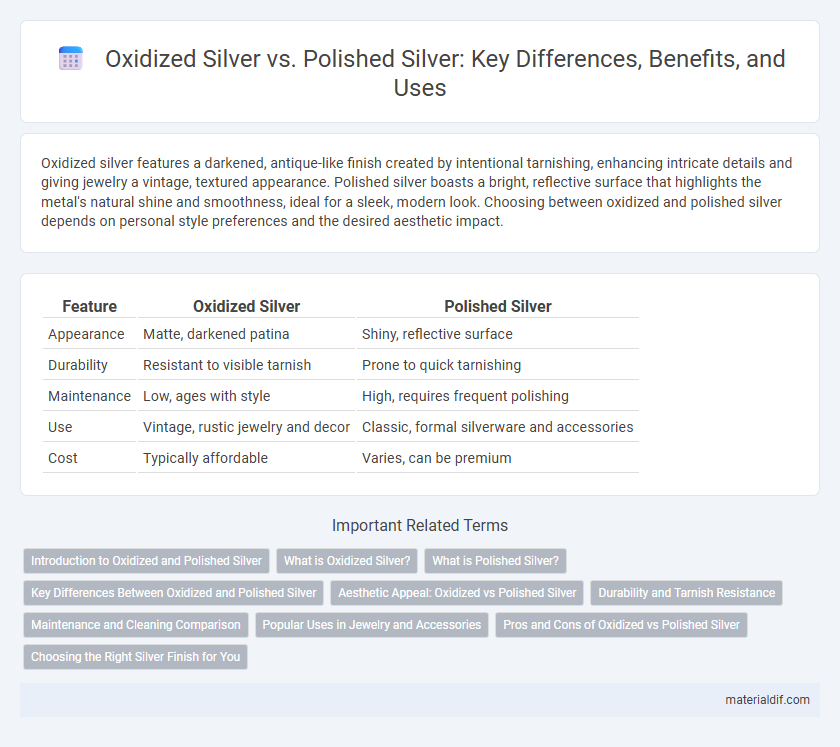Oxidized silver features a darkened, antique-like finish created by intentional tarnishing, enhancing intricate details and giving jewelry a vintage, textured appearance. Polished silver boasts a bright, reflective surface that highlights the metal's natural shine and smoothness, ideal for a sleek, modern look. Choosing between oxidized and polished silver depends on personal style preferences and the desired aesthetic impact.
Table of Comparison
| Feature | Oxidized Silver | Polished Silver |
|---|---|---|
| Appearance | Matte, darkened patina | Shiny, reflective surface |
| Durability | Resistant to visible tarnish | Prone to quick tarnishing |
| Maintenance | Low, ages with style | High, requires frequent polishing |
| Use | Vintage, rustic jewelry and decor | Classic, formal silverware and accessories |
| Cost | Typically affordable | Varies, can be premium |
Introduction to Oxidized and Polished Silver
Oxidized silver features a deliberate darkened surface achieved through a chemical process, enhancing texture and antique appeal, while polished silver boasts a bright, reflective finish created by buffing to a smooth shine. Both treatments highlight the metal's versatility, with oxidized silver offering a vintage aesthetic and polished silver emphasizing classic elegance. Understanding these finishes aids in selecting silver jewelry or decor that matches personal style preferences and desired visual impact.
What is Oxidized Silver?
Oxidized silver is silver that has undergone a controlled oxidation process to create a darkened, antique-like finish on its surface, enhancing details and texture. This treatment forms a patina by reacting silver with sulfur or other chemicals, providing a contrast that highlights intricate designs commonly used in jewelry and decorative pieces. Unlike polished silver, which has a smooth and shiny appearance, oxidized silver offers a matte, rustic look that resists showing everyday wear and scratches.
What is Polished Silver?
Polished silver refers to sterling silver that has been meticulously buffed and polished to create a smooth, shiny, and reflective surface, enhancing its natural brightness and appeal. Unlike oxidized silver, which features intentional darkened areas for an aged or antique look, polished silver maintains a bright, mirror-like finish that highlights intricate details and craftsmanship. This lustrous surface requires regular maintenance to preserve its shine and prevent tarnishing.
Key Differences Between Oxidized and Polished Silver
Oxidized silver features a darkened, matte finish created by a chemical process that enhances antique or vintage appeal, while polished silver exhibits a bright, reflective shine due to meticulous buffing and cleaning. The key differences lie in appearance durability and maintenance: oxidized silver is more resistant to showing wear or tarnish but may require re-oxidizing, whereas polished silver demands regular polishing to maintain its luster but offers a sleek, modern look. Choosing between the two depends on aesthetic preference and how much upkeep the wearer is willing to undertake to preserve the silver's finish.
Aesthetic Appeal: Oxidized vs Polished Silver
Oxidized silver features a darker, antique-like patina that enhances intricate details and provides a vintage, rustic aesthetic appealing to those who appreciate unique, character-rich jewelry. Polished silver exhibits a bright, reflective surface with a sleek and modern look, emphasizing clarity and shine that suits minimalist and contemporary styles. The choice between oxidized and polished silver ultimately depends on your preference for either a bold, textured appearance or a clean, luminous finish.
Durability and Tarnish Resistance
Oxidized silver features a darkened surface layer that enhances its resistance to scratches and hides wear, making it more durable for everyday use compared to polished silver. Polished silver is highly reflective and smooth but is more susceptible to tarnishing and requires frequent cleaning to maintain its shine. The oxidized finish effectively slows down tarnish formation by providing a protective barrier, while polished silver's exposed surface oxidizes faster when exposed to air and moisture.
Maintenance and Cleaning Comparison
Oxidized silver requires gentler maintenance to preserve its darkened finish, typically cleaned with mild soap and water or a soft cloth, avoiding harsh chemicals that can remove the patina. Polished silver demands frequent cleaning to maintain its bright shine, often using silver polish creams or cloths designed to remove tarnish and restore luster. Both types benefit from proper storage in anti-tarnish bags or cloths to minimize oxidation and tarnishing over time.
Popular Uses in Jewelry and Accessories
Oxidized silver is renowned for its antique finish, making it popular in vintage-style jewelry and accessories that emphasize intricate details and darkened crevices. Polished silver, with its bright and reflective surface, is favored for modern, minimalist designs and contemporary accessories that highlight sleek and shiny aesthetics. Both finishes cater to different fashion preferences, with oxidized silver offering a rustic charm and polished silver providing a timeless elegance.
Pros and Cons of Oxidized vs Polished Silver
Oxidized silver offers a darkened, antique look that enhances intricate designs and reduces visible scratches, making it ideal for vintage-style jewelry; however, it requires periodic maintenance to prevent excessive tarnishing. Polished silver shines with a bright, reflective finish that highlights the metal's natural luster and is easier to clean, but it shows scratches and tarnish more prominently over time. Choosing between oxidized and polished silver depends on the desired aesthetic and willingness to perform regular upkeep.
Choosing the Right Silver Finish for You
Oxidized silver offers a darkened, antique look that highlights intricate details and requires less frequent polishing, making it ideal for those seeking a vintage or rustic aesthetic. Polished silver has a bright, reflective surface that showcases classic elegance and demands regular maintenance to retain its shine, perfect for formal or contemporary styles. Selecting the right silver finish depends on your lifestyle, design preference, and willingness to maintain the piece's appearance.
Oxidized Silver vs Polished Silver Infographic

 materialdif.com
materialdif.com